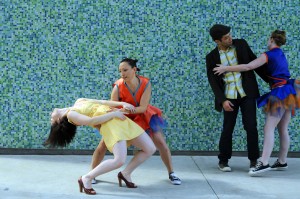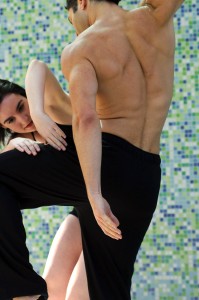My interview at 4dancers.org
10 Questions With…Lydia Hance
By 4dancers on June 25, 2010 in 10 Questions With…, 4dancers, 4teachers, Studios
Today 4dancers presents Lydia Hance, dancer and founder of Frame Dance Productions…

1. Can you tell readers about your dance background?
I grew up in the San Francisco Bay Area and began dancing at the ripe age of seven at the Marin Ballet, a pre-professional classical ballet school and continued through high school graduation. I attended Marin Academy for high school, a competitive intellectual-artsy institution. While dedicating myself to ballet outside of school, I began to see myself as an artist-dancer through the dance department at Marin Academy. By my senior year I produced my first evening-length production of my work in a professional theater. I then walked the straight and narrow technical path at Southern Methodist University training in ballet, jazz and Graham Technique and summered in New York at the Taylor School, Limon Institute, Graham School and NYU’s Tisch School of the Arts. While at SMU, I earned a BA in English Literature as well as a BFA in Dance Performance. The college-conservatory life (while it provided invaluable training and professors as resources) proved stifling to my creative spirit, and I worked very hard to complete both degrees early. After graduation, I moved to Houston, TX and danced with Suchu Dance Company, Ad Deum Dance Company, Dancepatheatre, and freelanced in various other projects. I have performed across the United States, from San Francisco to Times Square, and in Malaysia.
2. What are you currently doing in dance?
Currently, I dance with Suchu Dance—directed by Jennifer Wood—and various other choreographers and companies in Houston. I have also been creating works as an independent artist in Houston and as a Visiting Artist in Virginia. In May 2010, I launched my company, Frame Dance Productions. The first project for Frame was a dance-for-camera work called “Crease” which can be seen on the Frame Dance Productions website. I am currently artist-in-residence for the Community Dance Connection Theatre in Lexington, VA as part of the Rockbridge Artist Exchange. For the past three weeks I have been preparing material for Frame’s upcoming season in Houston. It’s been a fruitful retreat to create new work in the beautiful Rockbridge County, VA. I am excited to bring it back to Houston and begin rehearsals later this summer.
I teach at the Hope Center (Hope Stone, Inc.) and for the Dynamic X-Change Healing Arts Program, which is one of Several Dancers Core’s initiatives. The program uses dance and movement as a means to open up new pathways to joy, working with people of all ages who are isolated because of their circumstances —dealing with abuse, homelessness, aging, AIDS . . . . I also facilitate Fieldwork which is a rigorous weekly workshop designed to help artists of all disciplines gather information about their work.
3. Can you talk a bit about the unique direction you have chosen for Frame Dance Productions and why you selected it?
Sure. The purpose of Frame Dance Productions is to connect dance to the Web 2.0 social networking infrastructure, an emerging, media-rich forum for new creative expression. There is a lot of wonderful dance that is being created in Houston. And I work to be a voice in that dialogue. What makes Frame unique is our commitment to integrating technology into performances. The ways to do this are endless, but some examples are: dance made for the camera, simulcast live performances, integrating technology into live dance….
There is, very often, a disconnection between the performers/performance and the audience. That exists due to the nature of a performance—suspending reality for a period of time. It begins with the creative process and continues until the dancers leave the stage door at night. Frame Dance Productions is structured to allow audience awareness from the creative process through the performance—closing that elusive gap between artist and “non-artist.” It won’t be accomplished at once, and not all in one project. But we will break down parts of that divide a little at a time. (And I acknowledge that many performance-goers may not even want to partake in this specific aspect, which is always a respected option.) But the goal of Frame is to eliminate the super-exclusive artist club and invite those who are interested into the process through technology.
The Internet’s biggest shift has been the dawning of the age of social media, which is exactly what gives spectators the space to comment, question, and sometimes participate remotely in what goes on all over the world. Frame will integrate those platforms in its processes and performances. Additionally, Frame’s goal is to attract an extra-regional, and hopefully global, presence through web 2.0 and simulcast work.
4. How have people responded to your work?
Very positively, reviews can be read on the website at framedance.org. Frame is brand new, so I hope to continue to receive feedback to perpetuate discussion on the Internet AND in person.
5. Who are the people who have signed on for this and how did they sign on for this?
I have three categories of people who are integral parts of Frame Dance Productions. First, are the dancers. They are creative, open, talented individuals—just watch them dance! I invited them to dance with Frame because they are dancers who truly interest me as people and as movers. They are very smart. Second, is my husband and partner Jonathon Hance, Technology Director, who dialogues with me about potential concepts and projects and who dedicates himself to keeping current on technology—a never-ending task. He levels the technology stage upon which I create dance. Third, is you. Everyone who partakes and responds in the dialogue through commenting on the Frame Dance blog, through twitter, YouTube, email, discussions in person, or through simulcast conversations live as it’s happening. (Coming soon! Look out!) We’re early in the dialogue, but I hope to prove that this is a company that wants discussion and questions in any form, at any time. There is no “wrong.” I’ve had people tell me that they enjoy reading the blog but don’t have anything “deep and artsy” to say. That’s not what we’re looking for. We’re not looking for anything. We’re inviting anything.
6. What gets you excited about dance?

First, beauty. My eye and soul are drawn to beauty. I respect a synthesis of genres, vulnerability, commitment despite insecurity, exploring the uniqueness of individuals, and allowing that to inform the integrity of the work. I get very excited when dance is relevant to culture, but doesn’t compromise its truth to be current. And today, that’s wrapped up in technology. It’s important to know and understand what technology brings us, and to utilize it as an influential choreographic tool when creating work. Not technology incorporating dance—it’s about dance incorporating technology.
7. What do you find limiting about dance in the way that it has been done thus far?
People have been breaking boundaries since boundaries were built. There’s nothing new about doing something new. But the majority of dance is created for the stage. I find nothing wrong with three walls and rows of chairs. I enjoy creating work for that space. But why is that format still so dominant? Choreographers don’t make multiple pieces with exactly the same music and steps and timing and costumes and cast, but they create work after work after work for the same space. It’s a variable that’s hard to let go of. I find the overuse of proscenium stages limiting in how we frame dance.
8. Where do you see dance going as an art form?
I can’t say where it is going, but I do know where I hope it goes. As technology further penetrates us and we change how we live our lives, we become closer to our minds. We think faster, we process more information, and we make ourselves available and willing to know more about more. Our brains are dominant, but our bodies are, at best, secondary. Dr. Dominic Micklewright, from the University of Essex, put several successful sports gamers through tests to compare them to athletes. He said, ”their reaction time, motor skill, competitiveness and emotions were pretty close.” But when he tested their physical health he found that it was the equivalent of a sixty-year-old smoker. Because our minds are so stimulated by the information we access and process today it’s easy to rely on the power of our minds. And they are powerful. But our primal connection to our bodies requires activation, challenge and nourishment. I see dance providing that link— taking hold of all that technology can offer us, but remembering the importance, the beauty, the power, and the significance of the bodies we’ve been given.
9. Do you have any favorite dancers?
My company, of course! This is a hard question because I don’t watch dancers dance and naturally place them on a ranking scale. But I can tell you that dance has the most power to me when I know the dancers as people. I know their dreams and challenges. My favorite dancers are the ones I dance with and teach.
10. What’s next for you?
A lot! I’ll be speaking about Frame Dance Productions at SpaceTaker in Houston on July 21. We’ll perform a new work at the Contemporary Arts Museum in Houston on September 16, and “Crease” will be shown in the Weekend of Texas Contemporary Dance on September 24-25. In January, we will begin rehearsals for an evening-length piece to be performed in March, which is part of HopeWerks, a residency through Hope Stone, Inc. You can find out more on Twitter, Facebook, WordPress, and YouTube—all accessible through our website, www.FrameDance.org.
Bio: Lydia Polhemus Hance founded Frame Dance Productions in May 2010 out of her desire to connect dance with the vast, media-rich Internet culture, and to facilitate collaboration among diverse artists. Hance has performed the works of Steve Rooks, former principal of the Martha Graham Dance Company, Randall Flinn of Ad Deum Dance Company, Hope Boykin and Freddie Moore of Alvin Ailey Dance Company, Caleb Mitchell of Houston Ballet, among others. She has worked with several of these choreographers as a dancer with Ad Deum Dance Company. Lydia is currently a member of Jennifer Wood’s Suchu Dance and Dancepatheatre, directed by Sara Draper.
Her choreography has been performed in Kuala Lumpur, Malaysia and throughout the United States, including Times Square, San Francisco and Virginia, where Hance is a guest choreographer for Lexington’s Halestone Dance and Roanoke Ballet Theater. Hance is the Facilitator for Fieldwork Houston, a unique forum where artists of all genres gather to receive feedback on developing works. Her latest work for the stage, Dancing Diana, came from a partnership that was formed in Fieldwork. Dancing Diana, which showcases Hance’s collaboration with writer Diana Weeks, was performed at the Houston Fringe Festival and Danceplorations. Her dance-for-camera work “Crease” will be presented at the Weekend of Texas Contemporary Dance on September 25-26, 2010.
Lydia enjoys teaching students of all ages in institutions all over the United States and in Malaysia, including the Houston Metropolitan Dance Company, Houston Ballet, Marin Ballet, and Hope Stone, Inc. Lydia teaches in the Dynamic X-Change Program as part of Several Dancers Core’s initiative for healing for populations at risk.
Originally from San Francisco, California, Hance graduated Magna Cum Laude from Southern Methodist University with a B.F.A. in Dance Performance and B.A. in English Literature. She was named a recipient of the Meadows School of the Arts Artistic Merit Award. Lydia trained at the Taylor School, the Limon Institute, the Graham School, and at NYU’s Tisch School of the Arts.
Uncategorized